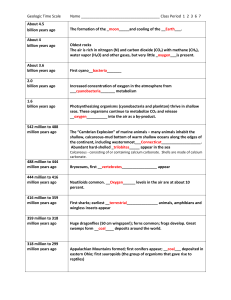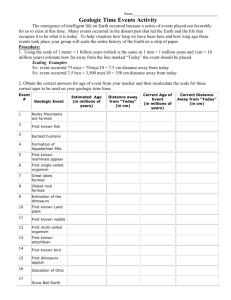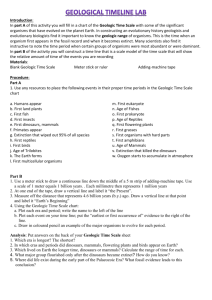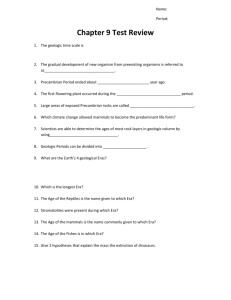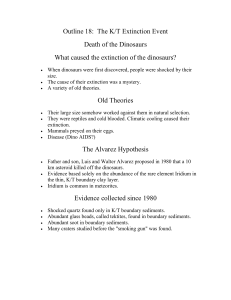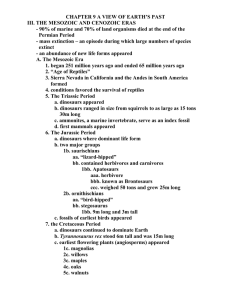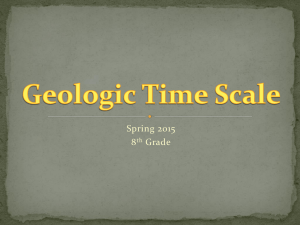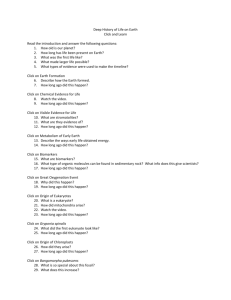project geologic tim..
advertisement
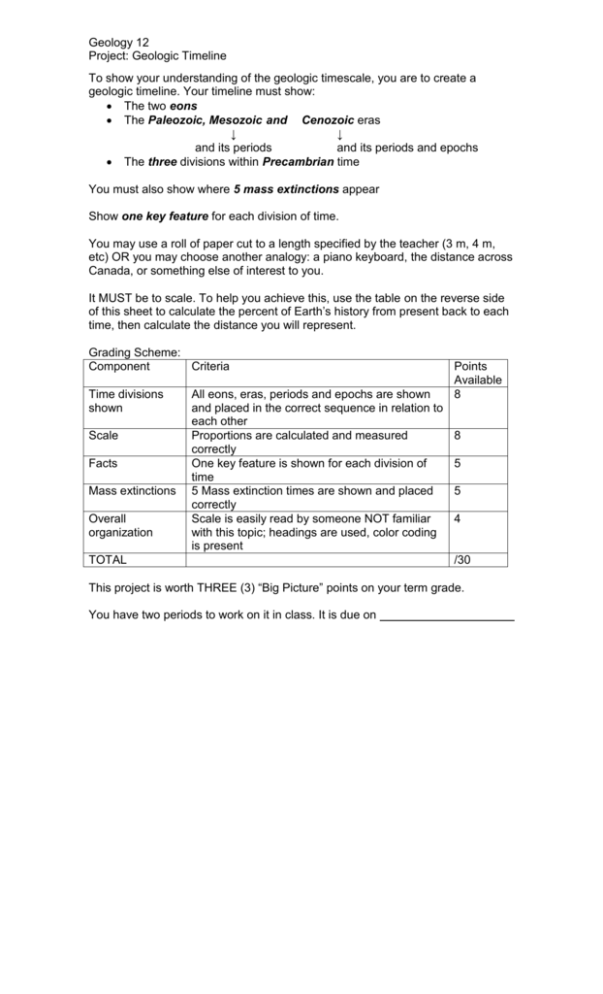
Geology 12 Project: Geologic Timeline To show your understanding of the geologic timescale, you are to create a geologic timeline. Your timeline must show: The two eons The Paleozoic, Mesozoic and Cenozoic eras ↓ ↓ and its periods and its periods and epochs The three divisions within Precambrian time You must also show where 5 mass extinctions appear Show one key feature for each division of time. You may use a roll of paper cut to a length specified by the teacher (3 m, 4 m, etc) OR you may choose another analogy: a piano keyboard, the distance across Canada, or something else of interest to you. It MUST be to scale. To help you achieve this, use the table on the reverse side of this sheet to calculate the percent of Earth’s history from present back to each time, then calculate the distance you will represent. Grading Scheme: Component Criteria Time divisions shown Scale Facts Mass extinctions Overall organization All eons, eras, periods and epochs are shown and placed in the correct sequence in relation to each other Proportions are calculated and measured correctly One key feature is shown for each division of time 5 Mass extinction times are shown and placed correctly Scale is easily read by someone NOT familiar with this topic; headings are used, color coding is present TOTAL Points Available 8 8 5 5 4 /30 This project is worth THREE (3) “Big Picture” points on your term grade. You have two periods to work on it in class. It is due on Geology 12 Project: Geologic Timeline EON ERA EPOCH MILLIONS OF YRS AGO Holocene .01 Rise of civilization and agriculture. Extinction of large mammals in northern hemisphere. Pleistocene 1.8 Modern humans appear. Four major glaciations cause rapid shifts in ecological communities. Pliocene 5 Extensive radiation of flowering plants and mammals. First hominids appear. Miocene 23 Coevolution of insects and flowering plants. Dogs and bears appear. Oligocene 38 Worldwide tropical rainforests. Pigs, cats, and rhinos appear. Dominence of snails and bivalves in the oceans. Eocene 54 Early mammals abundant. Rodents, primitive whales and grasses appear. Paleocene 65 Early placental mammals appear; first primates; modern birds. Cretaceous 146 Marsupials, ants, bees, butterflies, flowering plants appear. Mass extinction of most large animals and many plants. Jurassic 208 Dinosaurs and gymnosperms dominate the land; feathered dinosaurs and birds appear. Radiation of marine reptiles. Triassic 245 Origin of mammals, dinosaurs and true flies. Less diverse marine fauna. Permian 286 Gymnosperms, amphibians dominant. Beetles, stoneflies appear. Major extinction of 95% of marine species and 50% of all animal families. Pennsylvanian 325 First reptiles, cockroaches and mayflies appear. Extensive coal swamp forests. Sponge reefs. Missippian 360 Echinoderms, bryozoans dominant in oceans. Early winged insects. First coal swamp forests. Devonian 410 First amphibians. Extensive radiation of fish, land plants. Many corals, brachiopods and echinoderms. Silurian 440 First spiders, scorpions, centipedes, early insects, vascular plants, jawed fish and large reefs appear. Ordovician 505 First land plants, primitive fungi, sea weed appear. Diverse marine life: corals, molluscs, bivalves, echinoderms, etc. Cambrian 543 Rise of all major animal groups. Metazoan life abundant; trilobites dominant. First fish. No known terrestrial life. PERIOD proportion of total Quaternary C E N O Z O I C M E S O Z O I C MAJOR BIOLOGICAL EVENTS Neogene Tertiary Paleogene P H A N E R O Z O I C distance to show Carboniferous P A L E O Z O I C PROTEROZOIC 570 ARCHEAN 2,500 HADEAN 3,800-4,600 0.124 or 12.4% Origin of multicelled organisms. First sponges, colonial algae and soft-bodied invertebrates. 0.54 or 54 % Oxygen levels rise as a result of photosynthetic organisms. First eukaryotes (single-celled algae): 1.4 billion years old. Earliest life, anaerobic prokaryotes (bacteria, archaeans) originate 3.5 billion years ago. 1 or 100% No life known. Cooling and solidifying of Earth's crust.
